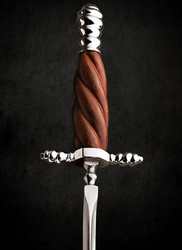Italian Stiletto Knives : A Comprehensive Guide
19th Feb 2024
Welcome to our deep dive into the world of stiletto knives, a symbol of both elegance and controversy. These slender, pointed knives have a rich history, from their origins as Italian daggers to their modern-day iterations. In this guide, we'll explore what stiletto knives are, their unique characteristics, and the legal landscape surrounding them.
What Are Stiletto Knives?
Stiletto knives, often referred to simply as stilettos, are not just any ordinary knives. They feature a long, slender blade and a needle-like point, designed primarily for stabbing. Historically, stilettos were used as stabbing weapons, but today, they are also popular as collectible items and self-defense tools.
The Anatomy of a Stiletto Knife
Understanding what makes a stiletto distinct involves looking at its parts:
- Blade: Thin and sharp, ideal for piercing.
- Handle: Often includes a mechanism for deploying the blade, such as a button or switch in automatic varieties.
- Lock: A safety feature to prevent accidental deployment or closure.
Types of Stiletto Knives
- Original Stiletto Knife: Traditional design, focusing on piercing.
- Stiletto Milano Knife: A variant known for its craftsmanship and design, originating from Milan.
- Authentic Italian Stiletto Knives: Renowned for their quality and historical accuracy in design.
- Italian Stiletto Automatic Knife: A modern automatic version that springs the blade open with a button press.
- Keychain Stiletto Knife: A compact version designed for portability.
Stiletto knives occupy a grey area in many jurisdictions, with laws varying widely from one place to another. Some regions classify stilettos as weapons due to their design and potential use in crimes. It's crucial to research local laws, as legality can vary not just by country but within states or regions in a country.
How to Handle a Stiletto Knife Safely
- Opening and Closing: Many stilettos, especially automatic or switchblade types, have specific mechanisms for safe operation.
- How to Close a Stiletto Knife: Always ensure the blade is fully retracted and locked before storing.
Conclusion:
Stiletto knives are more than just tools; they are a part of history, a piece of art, and for some, a question of legality. Whether you're a collector, a historian, or simply curious, understanding these fascinating knives is a journey into a sharp and pointed part of our culture.


 Gift Cards
Gift Cards
